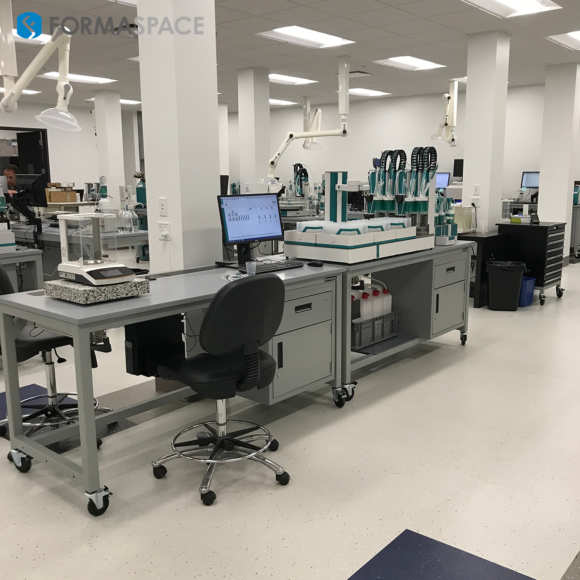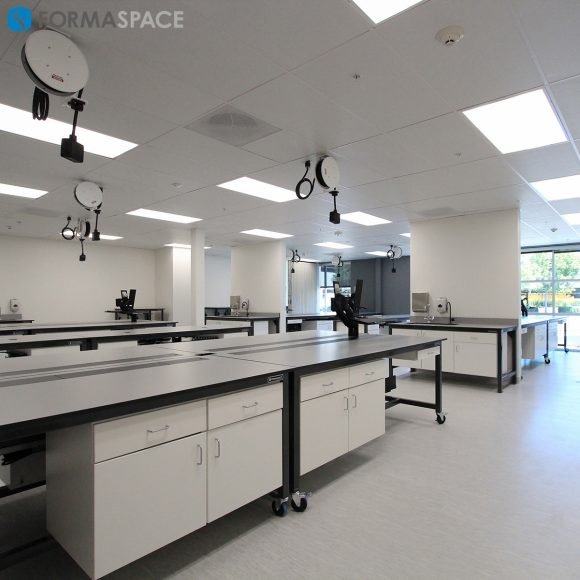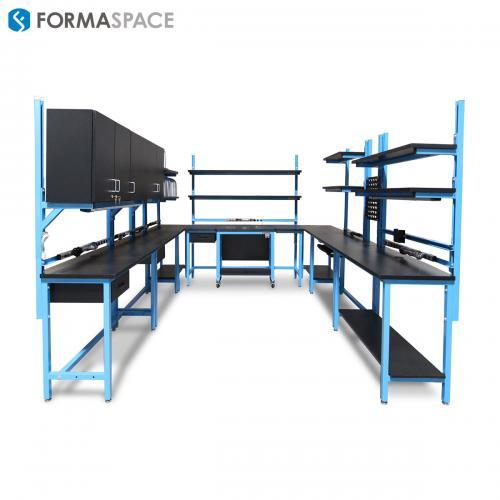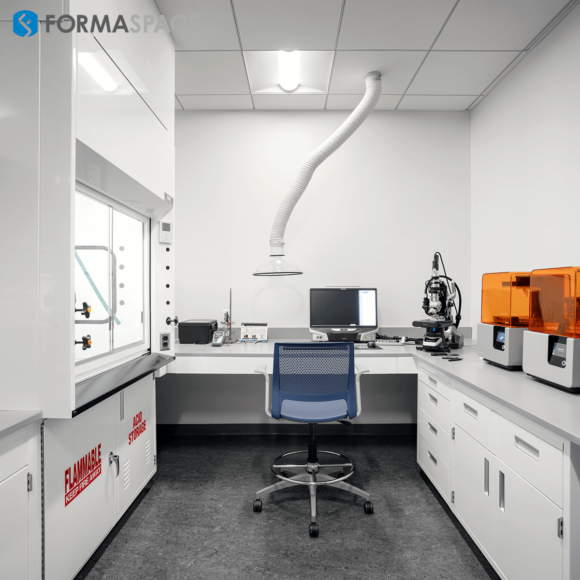The Changing Dynamics of Laboratory Science Research
Scientific knowledge is increasing at a faster pace than ever before — according to some experts, it’s doubling every 4 to 5 years.
At the same time, science is becoming increasingly data-oriented, thanks to the proliferation of next-generation measurement tools that can create larger, more accurate data sets than ever before.
What do these developments mean for scientists and lab professionals?

As we enter the new decade, we take a look at ways the scientific community can respond to these challenges and take advantage of the opportunities that lie ahead.
What are the Roadblocks to Creating the Lab of the Future?
Research organizations and lab facilities need to make structural changes to take advantage of today’s data-driven approach to science.
Why?
The advent of “big data” is driving the scientific community to adopt a more collaborative approach to research — one that relies on different disciplines (and even different institutions) coming together to solve some of the world’s most difficult research problems.
But making the transition to the more collaborative “lab of the future” is a challenge.
Here are four specific areas that you should consider when planning your next laboratory to make sure it’s not obsolete before its time:

Interaction: Turn Your Laboratory into a Model of Scientific Collaboration
Unlike the lab designs from an earlier era, which isolated research teams from one another, today’s lab managers and facility planners are turning to a “Team Science” approach that brings different research groups and disciplines together where they can interact with one another.
In order to quantify the effectiveness of this approach, researchers at the University of Michigan have created a new design metric, dubbed Zonal Overlap, to measure the impact. They found that “for every 100 feet of zonal overlap, collaborations increased by 20 percent and grant funding increased between 21 and 30 percent.”
Here are our top recommendations for increase interactivity between your different teams:
Keep all the laboratories together on one floor.
University of Michigan researchers found that co-locating all labs on the same floor dramatically increased the chances for spontaneous interaction.

Neighborhood-style meeting areas create a community spirit.
Add casual seating areas near elevator banks or build an on-site cafeteria. Formaspace Design Consultants can show you how.
Encourage impromptu meetings in small huddle areas.
Huddle rooms (semi-enclosed meeting areas) are ideal for gathering together team members to discuss issues.
Don’t segregate data labs from wet lab areas.
As the role of data analysis becomes more central to scientific discovery, there is a tendency to segregate it away from wet lab areas. Resist this to encourage interactivity between teams.

Create quiet areas for study and reflection.
Many individuals find they do their best thinking in private study areas or on-site libraries. The investment is worth it.
Virtualization: It’s all about Virtual Meetings, Virtual Lab Access, Virtual Notebooks, Virtual Assistants, and Virtual Experiments
In some respects, the research community has been relatively slow in adopting productivity technologies that have long been commonplace in the business world.
But we predict that 2020 will be the year that we see greater adoption, particularly in virtual tools.
Here are five areas to watch:
Virtual Meetings
With joint research projects on the rise, lab researchers are becoming more open to collaboration tools, such as Slack, that allow instantaneous communication. Modern laboratories are also building dedicated conference rooms adjacent to lab areas for quick group meetings that can be broadcast in high-fidelity to teams based at remote locations.

Virtual Notebooks
The idea of electronic lab notebooks (ELNs) has been with us for a while, but the need to share discoveries between teams is driving lab managers to take a second look at how to deploy these systems.
Virtual Assistants
Using voice assistant technology (a la Alexa or Apple’s Siri) could drive increased adoption of ELNs in 2020. Companies such as Lab Twin are working hard to make it easy to use virtual assistants to record data; this is especially useful in bio-safety labs where personnel are suited up, and ungloving to use a pen to write is both time consuming and potentially dangerous.
Virtual Access
Bio-Bright is another vendor who is promoting the use of modern ELNs. They are working on solutions that can capture data directly from the recording channels of advanced scientific equipment. This approach not only keeps a permanent record, it opens up virtual access to lab data for use by research partners.
Virtual Experiments
As our body of scientific knowledge expands, and we create more realistic virtual representations of the physical world, more and more scientific experiments can be conducted virtually in software. Advantages of this approach include increased physical safety for researchers studying dangerous pathogens or chemicals, as well as increased speed of discovery — and advances in AI/Machine Learning are expected to dramatically increase these capabilities (see automation section below).
Visualization: The Laboratory of the Future Relies on Advanced AR/VR Technologies and More to Visualize Data and Processes

Scientific visualization has been one of the key drivers of advanced computer technology.
Case in point is the 3D video of photosynthesis (shown above), which won top awards at this year’s SC19: The International Conference for High Performance Computing, Networking, Storage, and Analysis.
The video illustrates the power that visualization offers in communicating complex scientific knowledge, whether to other scientists or, in this case, to a lay audience.
But, while long-form 3D animations have their advantages, more and more laboratories are looking at the potential of interactive visualization technologies derived from the games industry, such as AR (augmented reality) and VR (virtual reality).
How can these be used in a lab environment? Taking a cue from the business world, lab managers are exploring the potential of using AR and VR for training new personnel in the best practices of laboratory safety.
Immersive AR/VR environments can be used to teach participants the importance of wearing appropriate personal protective equipment (PPE), practice suiting up and decontamination procedures before entering clean rooms or bio-safety labs, as well as specific handling procedures to avoid respiratory issues or accidents such as chemical spills or needle sticks.

Automation: What will be the Role of Robotics, Machine Learning, and AI Technologies in the Laboratory of the Future?
Robot-powered assay handlers have been a mainstay in laboratory facilities since the 1980s. And co-bots (robots designed to work safely alongside humans) offer new opportunities for automating laboratory processes.
But it’s the rapid advances in artificial intelligence, machine learning, and advanced robotics that are poised to make much more fundamental, even revolutionary, changes to the scientific process as we enter the 2020s.
Already, artificial intelligence methods have proven their ability to analyze and make sense of vast databases — think of facial recognition technology as one example.

So the question regarding mainstream use of AI and machine learning is less “if” (the answer is ‘yes’) and “when” (the answer is ‘now’) than exactly how will the laboratory of the future take advantage of the new opportunities — and what is the role of the human scientist in all this?
For now, the role of humans is secure — after all, AI / machine learning systems need to be trained (ideally with huge datasets) to perform anything useful. And once they are properly prepared, they can make quick work of analyzing massive data sets to identify patterns or perform the less interesting, more mundane tasks.
So, for the immediate future, the role of the human scientist and the machine is one of collaboration — each does the work that is best suited for it: humans create the data models, and machines crank out the analysis.
Is this how the story ends? It’s not yet clear.
As the AI tools become ‘smarter,’ they can create for useful structures— ones that may go beyond what most humans can conceive of. A case in point is the new field of “Generative Design” — a rapidly growing AI-based discipline in the engineering world, where AI tools are being used to evaluate hundreds of thousands (if not millions) of design alternatives before proposing the most suitable solution for a given problem.
We can expect to see the development and adoption of a similar “Generative Science” approach becoming a mainstream solution for scientific research in the laboratory of the future.

Formaspace is Your Laboratory Partner
As a GSA Schedule Supplier, Formaspace has helped our lab clients build out their laboratories across the full spectrum of government, military, education, and commercial entities, including well-known companies, such Roche, Schlumberger, and Antech Diagnostics.
Take advantage of our expertise.
If you are interested in learning more about how we can help you design your dream lab or renovate your existing one, contact your Formaspace Design Consultant today.
We’re ready to help you next.














